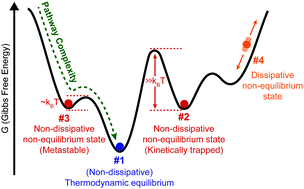当前位置:
X-MOL 学术
›
Chem. Soc. Rev.
›
论文详情
Our official English website, www.x-mol.net, welcomes your feedback! (Note: you will need to create a separate account there.)
Non-equilibrium supramolecular polymerization
Chemical Society Reviews ( IF 46.2 ) Pub Date : 2017-03-28 00:00:00 , DOI: 10.1039/c7cs00121e Alessandro Sorrenti 1, 2, 3, 4 , Jorge Leira-Iglesias 1, 2, 3, 4 , Albert J. Markvoort 5, 6, 7, 8 , Tom F. A. de Greef 5, 6, 7, 8 , Thomas M. Hermans 1, 2, 3, 4
Chemical Society Reviews ( IF 46.2 ) Pub Date : 2017-03-28 00:00:00 , DOI: 10.1039/c7cs00121e Alessandro Sorrenti 1, 2, 3, 4 , Jorge Leira-Iglesias 1, 2, 3, 4 , Albert J. Markvoort 5, 6, 7, 8 , Tom F. A. de Greef 5, 6, 7, 8 , Thomas M. Hermans 1, 2, 3, 4
Affiliation

|
Supramolecular polymerization has been traditionally focused on the thermodynamic equilibrium state, where one-dimensional assemblies reside at the global minimum of the Gibbs free energy. The pathway and rate to reach the equilibrium state are irrelevant, and the resulting assemblies remain unchanged over time. In the past decade, the focus has shifted to kinetically trapped (non-dissipative non-equilibrium) structures that heavily depend on the method of preparation (i.e., pathway complexity), and where the assembly rates are of key importance. Kinetic models have greatly improved our understanding of competing pathways, and shown how to steer supramolecular polymerization in the desired direction (i.e., pathway selection). The most recent innovation in the field relies on energy or mass input that is dissipated to keep the system away from the thermodynamic equilibrium (or from other non-dissipative states). This tutorial review aims to provide the reader with a set of tools to identify different types of self-assembled states that have been explored so far. In particular, we aim to clarify the often unclear use of the term “non-equilibrium self-assembly” by subdividing systems into dissipative, and non-dissipative non-equilibrium states. Examples are given for each of the states, with a focus on non-dissipative non-equilibrium states found in one-dimensional supramolecular polymerization.
中文翻译:

非平衡超分子聚合
传统上,超分子聚合一直专注于热力学平衡状态,在该状态下,一维组装体处于吉布斯自由能的全局最小值。达到平衡状态的途径和速率无关紧要,并且所得装配随时间保持不变。在过去的十年中,重点已经转移到动力学陷阱(非耗散性非平衡)结构上,该结构在很大程度上取决于制备方法(即途径复杂性),并且装配速率在其中至关重要。动力学模型极大地改善了我们对竞争途径的理解,并展示了如何在所需方向上引导超分子聚合(即,路径选择)。该领域的最新创新依赖于耗散的能量或质量输入,以使系统远离热力学平衡(或远离其他非耗散状态)。本教程复习旨在为读者提供一套工具,以识别到目前为止已探索的不同类型的自组装状态。特别是,我们旨在通过将系统细分为耗散状态和非耗散性非平衡状态,来澄清术语“非平衡自组装”的经常不清楚的用法。给出了每个状态的例子,重点是在一维超分子聚合中发现的非耗散非平衡状态。
更新日期:2017-09-18
中文翻译:

非平衡超分子聚合
传统上,超分子聚合一直专注于热力学平衡状态,在该状态下,一维组装体处于吉布斯自由能的全局最小值。达到平衡状态的途径和速率无关紧要,并且所得装配随时间保持不变。在过去的十年中,重点已经转移到动力学陷阱(非耗散性非平衡)结构上,该结构在很大程度上取决于制备方法(即途径复杂性),并且装配速率在其中至关重要。动力学模型极大地改善了我们对竞争途径的理解,并展示了如何在所需方向上引导超分子聚合(即,路径选择)。该领域的最新创新依赖于耗散的能量或质量输入,以使系统远离热力学平衡(或远离其他非耗散状态)。本教程复习旨在为读者提供一套工具,以识别到目前为止已探索的不同类型的自组装状态。特别是,我们旨在通过将系统细分为耗散状态和非耗散性非平衡状态,来澄清术语“非平衡自组装”的经常不清楚的用法。给出了每个状态的例子,重点是在一维超分子聚合中发现的非耗散非平衡状态。



























 京公网安备 11010802027423号
京公网安备 11010802027423号